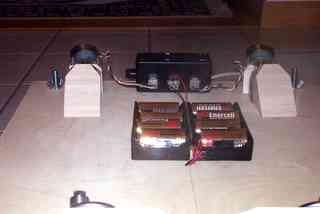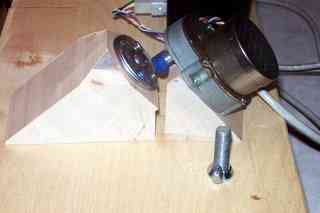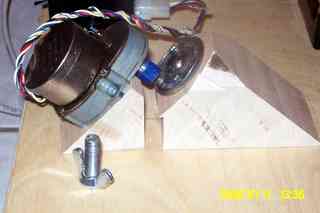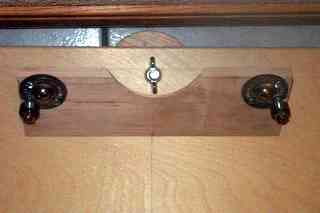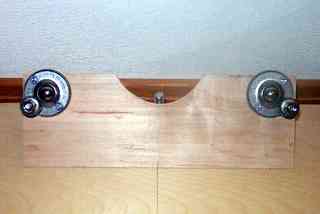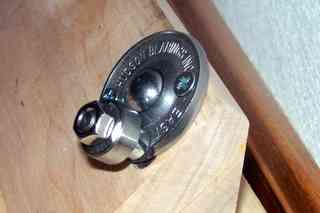Click on the pictures to see larger pictures, and use your browser BACK button to return here!
The two north bearing mounts on the base, from the south end of the base. The two battery boxes (4 D-cells each) and the main electronics drive box are visible.
Side view of the northeast bearing mount. The motor mount
(the motor shaft bears radial load) is part of this, but is
a separately adjustable mounting block.
Side view of the northwest bearing mount. The motor mount
(the motor shaft bears radial load) is part of this, but is
a separately adjustable mounting block.
A vertical view of the south bearing mount
There are two ball transfer and ball bearing
assemblies mounted on this mount. Each provides
axial and radial bearing support on this mount.
The south bearing mount is simply aligned parallel
to the edge of the base board.
This view of the south bearing mount has a line of
sight parallel to the virtual polar axis.
There are two axial and
two radial bearings on this mount. The bearing assemblies
are mounted with the radial load bearings outboard of the
ball transfer (axial load) support points.
One of the two south bearing assemblies on the south
bearing mount. You can see the assembly technique
mounting the standard ball bearing on a machine screw
with a spacer. There are two axial and
two radial bearings on this mount.
Bearing Considerations
Geometry Factors
Ideally, there will be five points of constraint to configure the platform motion. Using Chuck Shaw's and Warren Peters' designs as a basis, however, additional bearings are used. Additional bearings require additional alignment.
In the two referenced designs, ball bearings (or roller skate wheels) are used to support the table's sector arcs. Two axial load support bearings are used for each sector, and two radial load support bearings are used as well.
I followed the suggestion of several constructors, but Brian Reed (maker of the "Round Table Platform") was the principal inspiration for me. As Brian did, I chose to use "Ball Transfer" bearings to support the axial load. Ball Transfers will support the axial load without requiring more than 1-dimensional alignment, if they can bear against a smooth side of the arc sector.
The radial load on the south end of the platform is supported by "normal" ball bearings -- I chose 1/4 inch shaft and 3/4 inch diameter bearings mounted to the ball transfer on a 1/4 inch machine screw with a 1/4 inch long spacer. This rigid assembly is then mounted on a maple block cut to align the ball bearing's axis parallel with the virtual polar axis.
Foot Construction
I was unable to find 1/4 inch diameter and 1/4 inch long spacers in stainless steel, but I could find the right diameter in 3/4 inch length. I carefully cut two 1/4 inch long spacers from each 3/4 inch spacer. The care was needed because of the small size of the pieces.
The bearing support blocks were laminated from nominal 1x4 inch (actual 3/4 inch by 3-1/2 inch) stock and then cut to size. It was fortuitous that the finished block of 3 inches by 3-1/2 inches provided a diagonal dimension and angle very close to the desired 42 degrees -- my design latitude, close to my actual latitude of 41.86 degrees.
The north bearings are mounted on two separate blocks for the axial bearings (ball transfers again) and two separate blocks supporting the stepper motors whose shafts (with 1/2 inch diameter drive wheels mounted) serve as the radial bearings for the north sector.
Other notes in these pictures
Bolts and wing-nuts for the feet appear in some of the pictures.
South bearing alignment was greatly simplified by using a single mount for the two bearing assemblies.
